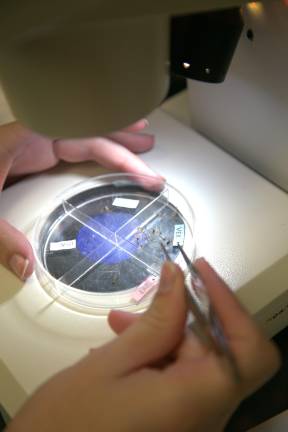SUNY Orange has been studying mosquitos for decades
Middletown. Students’ research continues to support county Department of Health efforts.

Did you know that studies in Orange County that identify West Nile virus or other mosquito-borne illnesses may have been made possible by SUNY Orange students?
For 25 years, students at the college have worked side by side with experts from SUNY Orange, the New York State Department of Health, and the Orange County Department of Health on a mosquito surveillance project that protects the community and gives students hands-on field experience in science and public health.
Each summer, three to six students are selected to join the team. They apply for the opportunity and then dive into weeks of intense, on-the-job training.
Their work is anything but routine. Students learn how to set traps, collect samples, and identify hundreds of mosquito species under a microscope. At the height of summer, they may process upwards of 1,000 mosquitoes in a single day, sorting them into petri dishes and looking for fine details such as hairs under the wings, the shape of the abdomen, or even the “booties” on the feet that distinguish one species from another.
“This is quite a responsibility,” said Dr. Michele Iannuzzi-Sucich, professor of biology and project coordinator. “It is amazing how quickly the students pick it up. Of course, we have experts checking every vial.”
The program began in 2000, when student researchers led by professor emeritus Tom Alford discovered that West Nile virus was the cause of widespread bird deaths. Today, Iannuzzi-Sucich leads the project with assistant coordinator Samuel Dillon, laboratory supervisor Marie DeFazio-Schultz, and mosquito experts Alford and John Kokas, a retired entomologist with the New York State Department of Health.
Students work throughout Orange County, with trap locations kept confidential as part of the College’s agreement with the Department of Health. After collection, the specimens are frozen in dry ice, identified, and prepared for additional testing at state labs in Albany. Data is shared with the Centers for Disease Control and Prevention and local officials. In addition to West Nile virus, the team has encountered mosquitoes capable of transmitting Zika and continues to watch for emerging threats.
For students, the project has immediate value. They receive paid research positions, build strong résumés, and develop skills in both laboratory science and fieldwork. Many graduates take what they learn into advanced study or careers in biology, public health, and medicine.
“This was so meaningful for me, I actually changed majors,” said Sophia Izzo, who is completed her second summer on the project. “I started at SUNY Orange interested in the Rad-Tech program and taking the prerequisites, but the mosquito project opened my eyes to new possibilities. Dr. Iannuzzi-Sucich recognized how much I enjoy training new students and that encouraged me to pursue education. I’ve come to love SUNY Orange and especially appreciate how much the professors care.”
Izzo, of Beacon, has since switched her major to education and is pursuing the College’s Jointly Registered Teacher Education Program 7–12 curriculum with plans to continue her studies at SUNY New Paltz.
The mosquito project is more than a summer job. For SUNY Orange students, it is a chance to make a difference in their community while gaining an academic and professional edge.